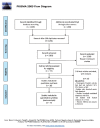Stem Cell Therapy for Neurogenic Bladder Dysfunction in Rodent Models: A Systematic Review
- PMID: 33017895
- PMCID: PMC7538284
- DOI: 10.5213/inj.2040058.029
Stem Cell Therapy for Neurogenic Bladder Dysfunction in Rodent Models: A Systematic Review
Abstract
Purpose: Neurogenic bladder dysfunction (NGB) has an impact on the quality of life, which made it an important research subject in preclinical studies. The present review investigates the effect of stem cell (SC) therapy on bladder functional recovery after the onset of spinal cord injury (SCI), multiple sclerosis (MS), Parkinson disease (PD), and stroke in rodent models.
Methods: All experiments evaluated the regenerative potential of SC on the management of NGB in rodent models up to June 2019, were included. From 1,189 relevant publications, 20 studies met our inclusion criteria of which 15 were conducted on SCI, 2 on PD, 2 on stroke, and 1 on MS in the rodent models. We conducted a meta-analysis on SCI experiments and for other neurological diseases, detailed urodynamic findings were reported.
Results: The common SC sources used for therapeutical purposes were neural progenitor cells, bone marrow mesenchymal SCs, human amniotic fluid SCs, and human umbilical cord blood SCs. There was a significant improvement of micturition pressure in both contusion and transaction SCI models 4 and 8 weeks post-SC transplantation. Residual urine volume, micturition volume, and bladder capacity were improved 28 days after SC transplantation only in the transaction model of SCI. Nonvoiding contraction recovered only in 56 days post-cell transplantation in the contusion model.
Conclusion: Partial bladder recovery has been evident after SC therapy in SCI models. Due to limitations in the number of studies in other neurological diseases, additional studies are necessary to confirm the detailed mechanism for bladder recovery.
Keywords: Neurogenic bladder; Rodent models; Stem cell therapy; Systematic review.
Conflict of interest statement
No potential conflict of interest relevant to this article was reported.
Figures











Similar articles
-
Intra-bladder wall transplantation of bone marrow mesenchymal stem cells improved urinary bladder dysfunction following spinal cord injury.Life Sci. 2019 Mar 15;221:20-28. doi: 10.1016/j.lfs.2019.02.011. Epub 2019 Feb 5. Life Sci. 2019. PMID: 30735734
-
Urodynamic Parameters in Spinal Cord Injury-Induced Neurogenic Bladder Rats after Stem Cell Transplantation: A Narrative Review.Iran J Med Sci. 2020 Jan;45(1):2-15. doi: 10.30476/ijms.2019.45318. Iran J Med Sci. 2020. PMID: 32038054 Free PMC article. Review.
-
Neurogenic bladder dysfunction does not correlate with astrocyte and microglia activation produced by graded force in a contusion-induced spinal cord injury.Brain Res Bull. 2017 May;131:18-24. doi: 10.1016/j.brainresbull.2017.02.010. Epub 2017 Mar 3. Brain Res Bull. 2017. PMID: 28267560
-
Initiating daily acute intermittent hypoxia (dAIH) therapy at 1-week after contusion spinal cord injury (SCI) improves lower urinary tract function in rat.Exp Neurol. 2023 Jan;359:114242. doi: 10.1016/j.expneurol.2022.114242. Epub 2022 Oct 12. Exp Neurol. 2023. PMID: 36240880
-
Stem Cell Therapy in Spinal Cord Injury-Induced Neurogenic Lower Urinary Tract Dysfunction.Stem Cell Rev Rep. 2023 Aug;19(6):1691-1708. doi: 10.1007/s12015-023-10547-9. Epub 2023 Apr 28. Stem Cell Rev Rep. 2023. PMID: 37115409 Review.
Cited by
-
Harnessing the regenerative effects of human amniotic stem cells (hAFSCs) on restoring erectile function in a bilateral cavernous nerve crush (BCNC) injury rat model.Stem Cell Res Ther. 2024 Nov 5;15(1):400. doi: 10.1186/s13287-024-03972-1. Stem Cell Res Ther. 2024. PMID: 39501401 Free PMC article.
-
Bladder dysfunction following stroke: An updated review on diagnosis and management.Bladder (San Franc). 2024 Aug 23;11(1):e21200005. doi: 10.14440/bladder.2024.0012. eCollection 2024. Bladder (San Franc). 2024. PMID: 39301573 Free PMC article. Review.
-
Tissue Engineering and Stem Cell Therapy in Neurogenic Bladder Dysfunction: Current and Future Perspectives.Medicina (Kaunas). 2023 Aug 3;59(8):1416. doi: 10.3390/medicina59081416. Medicina (Kaunas). 2023. PMID: 37629705 Free PMC article. Review.
-
Human umbilical cord mesenchymal stem cells contribute to the reconstruction of bladder function after acute spinal cord injury via p38 mitogen-activated protein kinase/nuclear factor-kappa B pathway.Bioengineered. 2022 Mar;13(3):4844-4856. doi: 10.1080/21655979.2022.2036397. Bioengineered. 2022. PMID: 35152833 Free PMC article.
-
Clinical application of stem cell therapy in neurogenic bladder: a systematic review and meta-analysis.Int Urogynecol J. 2022 Aug;33(8):2081-2097. doi: 10.1007/s00192-021-04986-6. Epub 2021 Nov 12. Int Urogynecol J. 2022. PMID: 34767058
References
-
- Wein AJ, Rackley RR. Overactive bladder: a better understanding of pathophysiology, diagnosis and management. J Urol. 2006;175:S5–10. - PubMed
-
- Anderson KD. Targeting recovery: priorities of the spinal cord-injured population. J Neurotrauma. 2004;21:1371–83. - PubMed
-
- Hajebrahimi S, Chapple CR, Pashazadeh F, Salehi-Pourmehr H. Management of neurogenic bladder in patients with Parkinson’s disease: a systematic review. Neurourol Urodyn. 2019;38:31–62. - PubMed
-
- Hajebrahimi S, Azaripour A, Sadeghi-Bazargani H. Clinical and transperineal ultrasound findings in females with stress urinary incontinence versus normal controls. Pak J Biol Sci. 2009;12:1434–7. - PubMed
Grants and funding
LinkOut - more resources
Full Text Sources
Miscellaneous

